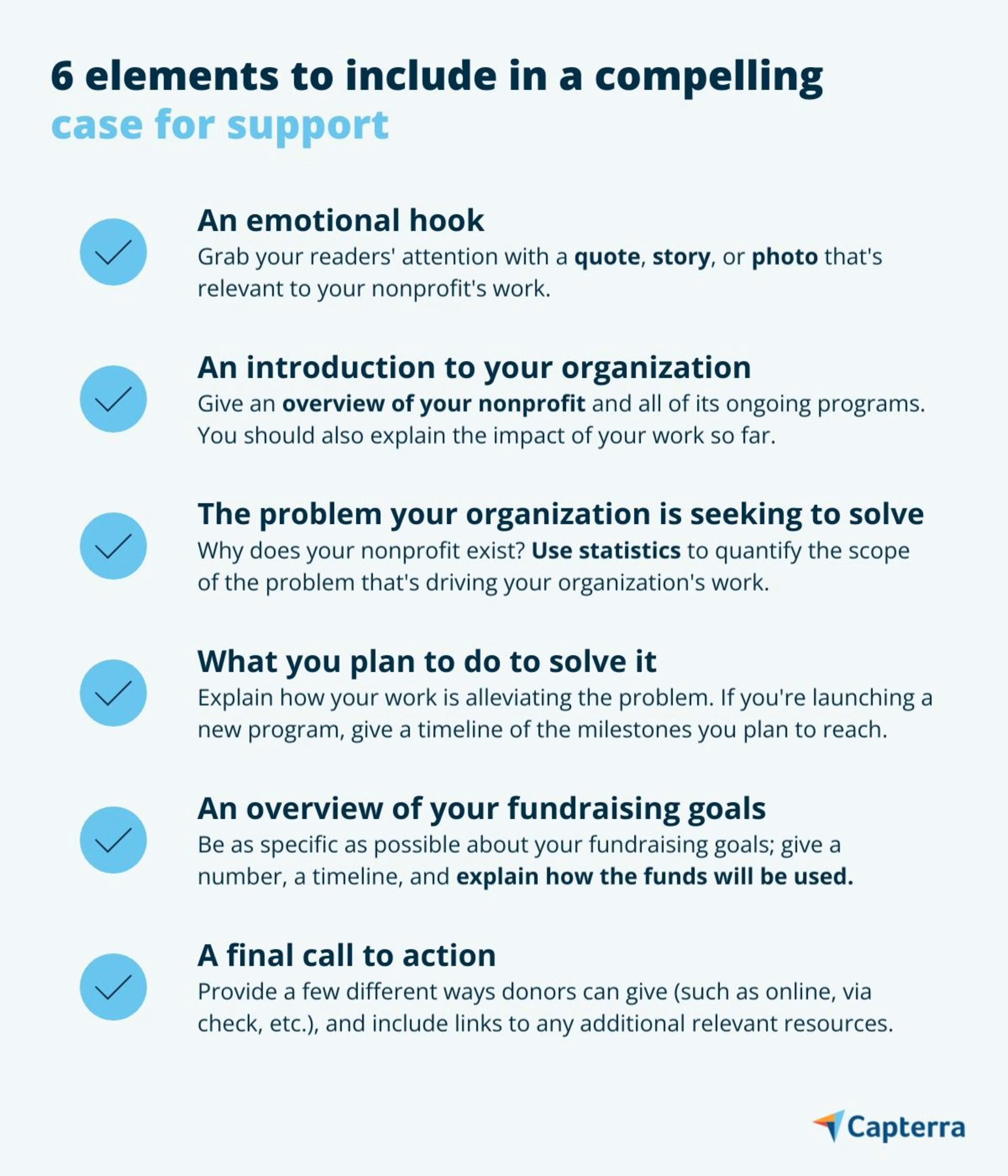Have an idea for a new nonprofit program? You’re five steps away from success.
In 2021, The Center for Effective Philanthropy[1] reported that 88% of nonprofits they surveyed altered their program offerings recently. With only 12% of existing nonprofits not needing to make any significant changes to their program lineup, there’s no denying the importance of prioritizing a scalable and adaptable program development process.
Whether your nonprofit is humming along soundly but is ready to launch a new program, or you’re just at the beginning of kicking off your very first service, you need a comprehensive understanding of how to navigate the new program development process in order to avoid experiencing the same fate of so many organizations like yours.
If you’re a program director or a nonprofit founder who’s looking for guidance at the onset of launching a new program, we’ve created this guide for you. Ahead, we’ll help you create a strategic plan for your latest program’s launch by covering each step of the nonprofit program development process and providing tips along the way that will ensure your success.
What is a nonprofit program?
A nonprofit program is an ongoing, organized effort to provide a service or support of some kind where needed. Not to be confused with an initiative, a program is a part of a nonprofit’s organization structure (rather than the nonprofit itself).
For example, Feed The Children[2] is a nonprofit initiative that’s been fighting hunger internationally for 40 years. They carry out their mission through multiple different nonprofit programs including a child sponsorship[3] program and a monthly giving subscription called The Table[4].
If you don’t already have an incorporated nonprofit, you should bookmark this guide and return to it when you’re ready to start program planning.
1. Conduct a needs assessment
A needs assessment is the process of determining whether there is an actual, quantifiable need for the work or service your nonprofit provides (or plans to). Conducting a needs assessment is an essential first step to take before you begin program planning—or starting a nonprofit at all, for that matter.
Here are the questions you should seek to answer while conducting your needs assessment:
How should we define the problem we’re setting out to solve?
Are there any existing organizations who are trying to solve the same problem?
What is the scope of the problem we’re trying to solve? For example, how many people would potentially use our services?
Where does our expertise (in regards to solving the problem) come from?
What this step boils down to is this: Do your research
A nonprofit is a business, and in the same way that a startup’s success is dependent on pre-launch market research, a nonprofit’s success is reliant on a thorough needs assessment.
If you’re not sure where to begin when it comes to finding answers to the questions above, we’ve listed three great starting places below:
Your community: If you know anyone who has experience with nonprofit management, you should ask for their feedback and guidance before launching a new program. Also, connect with members of the demographic you’re hoping to serve, and get their firsthand account of the problem and how it’s currently being handled by the community. One method you can try for collecting key information is to run a questionnaire or survey. This is also a great way to gauge your community’s interest in the service you’re planning to provide.
Census data: When it comes to answering the question of how many people your nonprofit could potentially reach, census data[5] is extremely helpful. And luckily, some municipal and regional planning groups also publish population-growth projections.
Foundation Center libraries: What better way to learn than from those who have gone before you? Foundation Center libraries[6] are home to comprehensive data on philanthropies from all over the world. You can look up funding trends, learn about nonprofits in your area (and who supports them), and apply to earn a seal of transparency (which will help you attract donors). Check out Candid[7] to learn more.
2. Assemble a team
If your needs assessment determines that there is enough cause to launch a new program, your next step is to start putting together a team. We’ll cover the three main types of nonprofit professionals and their responsibilities below, as well as how you can recruit them to your organization.
2.1 Board members
Every nonprofit’s highest priority should be to recruit a board of nonprofit leaders. Board members take on responsibilities related to furthering your organization’s mission, such as recruiting additional nonprofit professionals, overseeing the development of new programs, and ensuring legal compliance.
To find board members, we recommend reaching out to individuals in your network who share an interest in your cause. If your organization is well-established, your community of volunteers is a great place to look for new board members. You can also advertise board member openings on your website, as well as external job boards.
Want to know more? Read this: How to Find Nonprofit Board Members[8]
2.2 Staff
Your staff will include those who hold positions such as program director, events manager, communications specialist, and volunteer coordinator. Depending on how your organization operates, some of these roles will be more important than others, but because you’re here to learn how to start a new nonprofit program, we suggest that you prioritize finding a program director[9].
As staff members are paid for their work, the best approach to finding individuals to fill these roles is to post openings on job boards.
2.3 Volunteers
Many nonprofits rely on unpaid volunteers to raise awareness about their services, manage fundraising events, and run programs. But because volunteers offer up their time for free, recruiting new supporters will likely be an ongoing affair for your organization.
Recruiting volunteers is made easier by volunteer management software, a category of tools that helps nonprofits find, recruit, and train volunteers.
Software tip: If you’re worried about keeping your costs low, filter our various software directories by price to find free or low-cost options.
3. Create a program plan
Once you’ve got a team behind you to provide support and bounce ideas off, you should start program planning.
What is a nonprofit program plan?
A program plan is a document similar to a business plan that helps with grant writing as well as program development and refinement. Writing a program plan requires research and strategic thinking, but it is an essential step for program development.
In 3 Steps to Building an Effective Nonprofit Business Plan, we provide more in-depth information about how to do this, but to summarize, you should apply the principles of writing a business plan to program planning by including the seven components listed below.
Executive summary: Your executive summary should explain the what, why, and how behind your nonprofit. Introduce your organization, detail the problem(s) you’re seeking to solve, and briefly explain how you plan to do so. If you have a mission statement, it’s a good idea to include that here too.
Market analysis: Your market analysis should include a concise explanation of the need your program will serve, an overview of the demographics your program will target, and information about any other organizations that serve the same need. The needs assessment you conducted earlier will come in handy for this section.
Further reading: 4 Simple Steps to Completing a Market Analysis for Nonprofit Organizations[10]
Program operations overview: What will your new program entail? Will it be events-based or one-on-one social work between trained volunteers and those in need? Or, will it be more focused on providing resources to an underserved community? Whatever your idea for a new program entails, this is where you need to get specific about what you will provide, to whom, and how.
Staffing plan: Speaking of how you will carry out your program, your staffing plan should include a breakdown of who will be involved with managing the program. While we do recommend including a bio of your program director and any involved board members here, you don’t need to include the names of volunteers (just a headcount estimate).
Marketing strategy: How will you get the word out about your new program? And more importantly, how do you plan to connect with donors and volunteers? Having a marketing strategy in place is very important for any nonprofit, especially those launching new programs. Some marketing tactics frequently used by nonprofits include email campaigns, content marketing, word of mouth, social media promotion, and event marketing. And here’s a bonus tip: Google Ad Grants[11] offers up to $10,000 per month in free advertising for nonprofits.
Timeline/milestones: This is your “when” section. You should include when your program will launch and key organizational goals or milestones that will help you measure how effective your program is. Rather than include specific dates, we recommend setting time ranges here (such as 30 days, three months, six months, etc.).
Financials: Lastly, the most challenging section of all: financials. To start, we recommend conducting a feasibility study[12] and including a snapshot of the findings. Feasibility studies analyze all of the relevant factors influencing your programs’ success, including legal, financial, and logistical considerations. They are typically conducted by a third party, but the time and money spent is worth it, because the result will be a better understanding of your program’s chance of success and your community’s readiness to fund it. Aside from a feasibility study, you should also include a breakdown of cost estimates[13] for your program. Doing so will allow you to confidently set fundraising goals. Include projections for staff members’ salaries, overhead costs (such as rent and utilities costs), software subscriptions, and any other expenses you will incur throughout the course of doing business.
4. Write a case for support
At this point in the process, you’ve done a needs assessment, assembled a team, and worked through the process of creating a program plan. Next, you need to get the attention of potential donors with a case for support.
What is a case for support?
A case for support is a document put together by a nonprofit for prospective donors. The purpose of this document is to communicate what your organization does, the impact of your work, and most importantly, why a potential donor should support you.
We’ll briefly cover the components to include in a case for support below, but don’t miss our in-depth guide to writing an effective case statement: Here's What To Include in Your Nonprofit's Case for Support.

Once you’ve created a case for support, start thinking about the most effective way to share it with potential donors. Posting it on your website and emailing it directly to past donors are both great strategies. But if you have an event planned, you should also print physical copies to hand out to community members.
5. Launch your program
You’ve done your research; you’ve recruited a team, and now it’s time to launch your program and start making progress toward your goals. But don’t worry: We’ll leave you with some final parting tips to make sure your program launch goes as smoothly as possible.
Set a start date. Setting a launch date early on in the program planning process is a must. With a timeline in place, you’ll know when to start fundraising (usually at least a few months in advance), when to begin recruiting and scheduling volunteers, and when to begin measuring the impact of your new program (typically, between three to six months after launch).
Make an implementation plan. Your implementation plan should detail what needs to happen throughout the weeks leading up to (and after) launch. Do you need to hold a training session for volunteers? If so, who will be responsible for leading the session? Write down all of the to-dos your team needs to complete for a successful launch and make sure they’re each assigned to a team member. Nonprofit project management software can help you stay organized and on track ahead of your program’s launch.
Invest in resources that will bolster your program’s success. Whether it’s a new team member or new technology, there’s a good chance that you’ll have to make additional investments at some point to ensure your nonprofit grows. And while we can’t predict what your business will need, we can point you in the right direction. First, read our content, How to Work Towards Digital Maturity as a Nonprofit, then visit our Shortlist of Nonprofit Software for a breakdown of 10 top-rated tools frequently used by organizations such as yours.
Strategic thinking and preparation will improve your program’s chances of success
The Urban Institute’s Nonprofit Trends and Impacts 2021[14] report shared that 37% of nonprofit organizations experienced a decrease in donations in 2020. Obviously, this was in part due to the COVID-19 pandemic, but the economic challenges (such as explosive inflation and sky-high rent hikes[15]) facing our society have not gone away.
Considering these conditions, it’s more important than ever for nonprofits to think strategically about how they can fund and execute on the programs they promise to deliver. In order to set your nonprofit on a path to success, work through the five steps for developing a new program we’ve covered in this guide:
Conduct a needs assessment.
Assemble a team.
Create a program plan.
Launch your program.
And before you go, don’t miss our final roundup of helpful resources below.
Capterra tools and tips
Find your state association of nonprofits. Visit the National Council of Nonprofit’s website[16] to get connected with your local nonprofit association. Joining your state’s nonprofit association will help you gain visibility, recruit volunteers, and fund your programs.
Build a strong digital fundraising strategy. Use GlobalGiving’s Digital Fundraising Strategy Worksheet[17] to learn how to create a fundraising strategy that will allow you to reach ambitious funding goals.
Talk with your software vendors about nonprofit-specific pricing. Many software vendors offer their platform to nonprofits at a discounted price. If you’re planning on investing in new tools (or if it’s been awhile since you negotiated with your vendor about pricing), it’s worth verifying if this is an option for you.
Note: The applications mentioned in this article are examples to show a feature in context and are not intended as endorsements or recommendations. They have been obtained from sources believed to be reliable at the time of publication.


